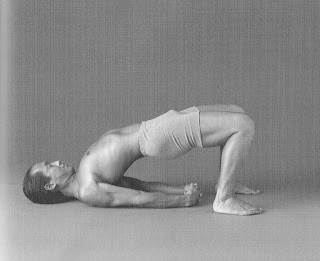by Baxter
I received this question a while back from one of our readers and thought today was the perfect day to address it:
“I often hear teachers instruct to come out of Bridge 'one vertebra at a time.' What are your thoughts on this? Is this healthier for the spine? Or is it in fact better to maintain the lower lumbar curve?”
It turns out that most of my first teachers would encourage just such an action when instruction for Bridge pose (Setu Bandha) with bent knees. In those days, I was practicing a style of yoga in which we would hold the poses for several minutes once in the shape of the pose. My instructors would often say to come up into Bridge one vertebrae at a time, as if your spine were taped to the floor and you were slowly peeling the tape off the floor. And they would suggest a similar action upon exiting the pose only in reverse: lower down slowly, one vertebra at a time, as if you were pressing the “tape” of the spine back onto the floor.
 |
| Bridge Pose (from "Yoga: The Poetry of the Body") |
The obvious question would be what are the advantages to the two different ways of getting in and out of the pose? The Peel Method, as I call it, is particularly well suited to the generally stiff student who does not have any lower back problems, specifically, but not exclusively, lumbar disc issues. For the healthy, stiff student, this way of moving in and out of Bridge pose creates more movement in certain directions between the individual bones of the lower spine, a bit more flexion (forward bending) than extension. So you can create better movement in a stiff part of the body using the Peel Method. And it is a fine way to work with healthy students who have normal flexibility as well.
However, in my specialty Back Care class, where lots of students have bulging or inflamed discs or structures in the lower back, there may be some instability and/or too much mobility that can result in increased pain. In addition, flexion (such as in a forward folding, rounded spine) which as I mentioned above, happens with the Peel Method, could potentially worsen disc problems and even run-of-the-mill general lower back pain. So the Elevator Method provides more stability to the lower spine, as well as encouraging a more neutral or natural curve in the lumber spine. I find that almost all of my Back Care students can not only do this variation without pain, but also seem to benefit from the overall strengthening of the back body muscles that come form this particular back bend.
There will always be some students who are exceptions to the above recommendations, and so each individual has to try the methods out for themselves and see which feels better for their body and seems to have the overall desired effects from regular practice. And, as with all asana, there are certainly other creative ways to get in and out of Bridge, so playing around to find a new way of working in the pose can add some fun to your home practice as well. I personally like to mix up the way I enter and exit poses a bit, so that I don’t get stuck in a rut of doing things the same way each time. This way of varying things keeps my attention more clearly focused on the task at hand, so I am more present with my regular asana practice. And this cultivation of moment-by-moment awareness in my yoga practice has great benefit for my everyday activities as well. In this way, I can move beyond the mere performance of yoga poses and reap the deeper benefits that yoga has to offer. So, play around with Bridge pose this week and see what you discover for yourself.















0 comments:
Post a Comment